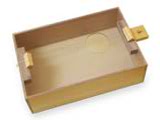-
[Experiment] Let's compare the thickness of the body The Structure of the Classical Guitar
Performing a sound [Experiment 1]
The design of the body is extremely important for classical guitars to produce a beautiful sounding timbre. Let's change the thickness of the wood used for the body to see how this changes the sound of the guitar.
-
Comparison of 5 mm and 15 mm thick wood Experiment steps
1. Set aside 5 mm and 15 mm wooden sheets and cut them into pieces to form a box.
2. Cut open a sound hole in each piece and assemble the box.
3. Attach fasteners and apply tension to the strings.
4. Pluck the strings and compare the sound produced.
Results of the experiment
5 mm body

15 mm body

* Cannot playback in the browser you are currently using.
* As this was an experiment, the recorded pitches differed from the correct notes.
Classical guitars are actually constructed of wood that is 3 mm thick, but the pieces used in this experiment are much thicker.
Both the 5 mm and 15 mm bodies have been fitted with string 1 of a classical guitar--the high E string. Plucking the string produces a very sharp sound with the 5 mm body; however, it produces a quiet, muffled sound with the 15 mm body. Wood that is too thick seems to adversely affect the sound produced.
Why, then, was the 15 mm body quieter than the 5 mm body?
Sound is generally produced by two factors. The first is the vibrations of the plucked strings transferring directly to the top via the bridge to produce sound. This is the main source of high pitched sound. Next, when the string is plucked, the string vibrates in the top, which in turn vibrates the air within the body. This is the sound that can be heard through the soundhole, and is the main source of low to medium pitched sound.
In our experiment, the body with 15 mm wood is thicker, which makes it harder to vibrate. Sound is not generated from the top and does not reverberate within the body, resulting in less sound.
Performing a sound [Experiment 2]
Harmonic bars play an important role in creating the timbre of classical guitars. What does it sound like without these harmonic bars? What about different materials? We checked the difference in sound produced.
-
Comparison with and without harmonic bars, and different materials Experiment steps
1. Set aside three sheets of acrylic to use for the top plate and cut open a sound hole.
2. Attach wood or polyurethane harmonic bars to the inner side of two sheets.
3. Attach the side and rear plates to each to create a box.
4. Attach fasteners and apply tension to the strings.
5. Pluck the strings and compare the sound produced.
Results of the experiment
Without any harmonic bars

Wood harmonic bars

Polyurethane harmonic bars

* Cannot playback in the browser you are currently using.
* As this was an experiment, the recorded pitches differed from the correct notes.
We have used a clear acrylic top so that the inside can be seen. Harmonic bars are usually long square sticks about 3 mm wide, but to highlight the differences in materials used, we have attached bars that are much wider.
The sound was loudest with no harmonic bars attached. Yet the quality of the sound seemed quite rough. Harmonic bars gave the sound a more lively quality. The sound is deeper. With polyurethane harmonic bars, the sound seemed to fade away quicker with a shorter resonance.
Comparing the sound produced with and without harmonic bars, we found that the sound had a higher pitch with harmonic bars attached. This is because the sound waves of vibrations are separated into areas between each harmonic bar. The smaller area vibrates faster and thus produces a higher pitched sound. If we could observe the areas vibrating, it would look something like this.
Using polyurethane harmonic bars reduces the strength holding the top and also the amplitude of vibrations. This produces a dull sound when compared with the tight, high pitched sound produced using wooden bars. The reduced resonance is due to the polyurethane absorbing some of the vibrations.


-
Choosing an Instrument

-




